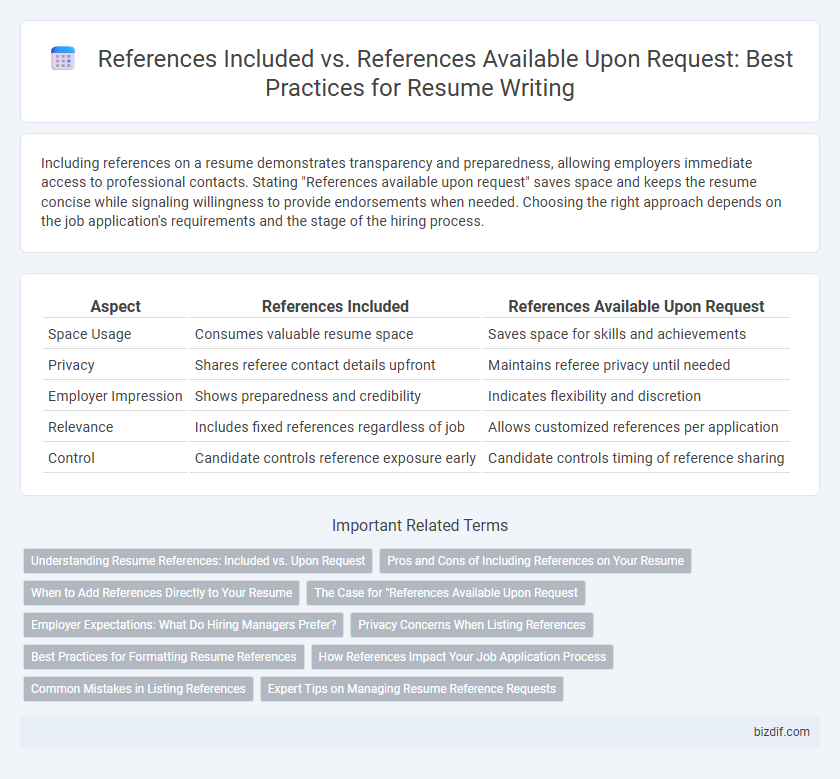Including references on a resume demonstrates transparency and preparedness, allowing employers immediate access to professional contacts. Stating "References available upon request" saves space and keeps the resume concise while signaling willingness to provide endorsements when needed. Choosing the right approach depends on the job application's requirements and the stage of the hiring process.
Table of Comparison
| Aspect | References Included | References Available Upon Request |
|---|---|---|
| Space Usage | Consumes valuable resume space | Saves space for skills and achievements |
| Privacy | Shares referee contact details upfront | Maintains referee privacy until needed |
| Employer Impression | Shows preparedness and credibility | Indicates flexibility and discretion |
| Relevance | Includes fixed references regardless of job | Allows customized references per application |
| Control | Candidate controls reference exposure early | Candidate controls timing of reference sharing |
Understanding Resume References: Included vs. Upon Request
Including references directly on a resume provides employers immediate access to contact information, demonstrating transparency and readiness. Listing references available upon request conserves space and allows candidates to control when and to whom sensitive personal contacts are shared. Understanding the strategic use of references enhances resume effectiveness and aligns with employer preferences in the hiring process.
Pros and Cons of Including References on Your Resume
Including references directly on your resume provides potential employers immediate access to credible endorsements, which can strengthen your application's authenticity and save time during the hiring process. However, it may consume valuable space that could be used to highlight skills or achievements and potentially expose your contacts to unsolicited inquiries. Opting for "References available upon request" maintains privacy and flexibility while allowing you to tailor your references to specific job applications, though it requires an additional step for employers to verify your credentials.
When to Add References Directly to Your Resume
Including references directly on your resume is recommended when applying for roles in industries like education, healthcare, or government, where immediate verification is crucial. Directly adding references streamlines the hiring process by providing trusted contacts upfront, demonstrating transparency and preparedness. Avoid listing references if the job posting explicitly requests "References available upon request" to maintain a clean and focused resume layout.
The Case for "References Available Upon Request
Including "References Available Upon Request" on a resume signals professionalism and respects the privacy of your contacts while keeping the document concise and focused. Employers appreciate this approach because it allows them to request references only when necessary, streamlining the hiring process and maintaining confidentiality. This phrase also demonstrates that you are prepared to provide credible endorsements without overwhelming the initial application with contact details.
Employer Expectations: What Do Hiring Managers Prefer?
Hiring managers generally prefer candidates to state "References available upon request" rather than listing references directly on the resume, as it saves space and allows for privacy considerations. Employers expect references to be provided during later stages of the hiring process when they are seriously evaluating the candidate. Including a dedicated reference section is less common and may be viewed as unnecessary unless specifically requested by the employer.
Privacy Concerns When Listing References
Including references directly on a resume can expose personal contact information, risking privacy breaches and unsolicited inquiries. Opting for "References available upon request" safeguards referee privacy by sharing details only with verified employers during later hiring stages. This approach balances professionalism with confidentiality, reducing the chances of data misuse or identity theft linked to publicly displayed references.
Best Practices for Formatting Resume References
Including references directly on a resume is generally discouraged to save space and maintain focus on skills and experience, while stating "References available upon request" informs employers that references can be provided without cluttering the document. Best practices for formatting resume references include creating a separate reference sheet with full contact details, using a consistent and professional layout, and ensuring references are relevant and recent to support your qualifications effectively. Employers appreciate clear, concise references that align with the job description and demonstrate verified professional relationships.
How References Impact Your Job Application Process
Including references directly on your resume provides employers immediate access to credible endorsements, enhancing trust and streamlining the evaluation process. Stating "References available upon request" may delay verification, potentially affecting the momentum of your application. Clear and relevant references can significantly influence hiring decisions by validating your skills and work ethic.
Common Mistakes in Listing References
Listing references directly on a resume often leads to clutter and reduces valuable space for showcasing skills and experience. Common mistakes include providing outdated contact information or failing to notify references beforehand, which can result in unprepared or unprofessional responses. Opting to state "References available upon request" preserves resume brevity while allowing candidates to control when and how references are shared.
Expert Tips on Managing Resume Reference Requests
Including references directly on your resume can demonstrate transparency and preparedness but may clutter the document and reduce focus on core qualifications; expert tips recommend listing references only if explicitly requested to keep the resume concise. Stating "References available upon request" signals professionalism and control over personal information, allowing you to tailor references for each job application strategically. Managing reference requests effectively involves maintaining an updated, curated list of professional contacts ready to provide positive endorsements, enhancing credibility without overwhelming recruiters during initial resume screening.
References included vs References available upon request Infographic

 bizdif.com
bizdif.com